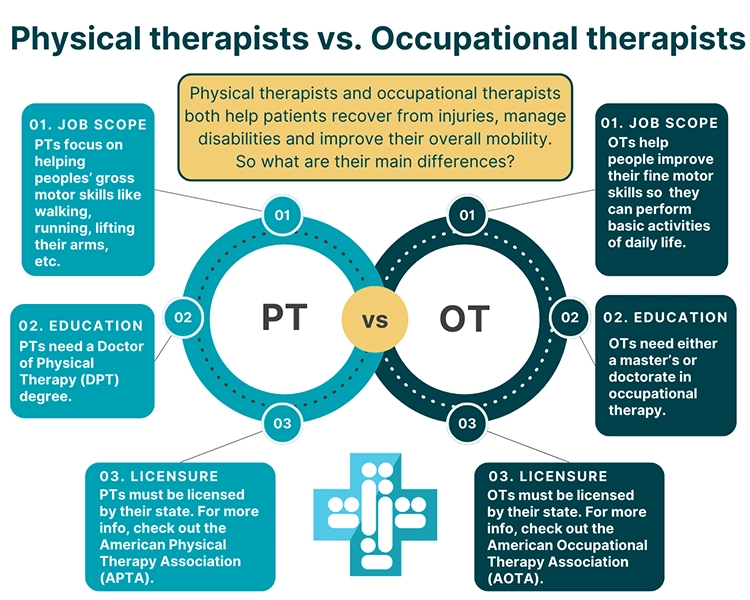
Occupational therapist vs. physical therapist. Which career is right for you? Both do vital hands-on rehabilitative work to help patients with injuries or disabilities that limit how they’re able to move and function in daily life.
PTs work primarily with people recovering from injuries. The goal is to get patients back in motion with exercises, massage and other techniques, and therapy usually happens in a PT’s office. Physical therapy often focuses on preventing injuries, and it can help people avoid surgery or a long-term reliance on medications.
OTs help their patients perform day-to-day tasks, whether they’re recovering from injuries or have developmental or cognitive disabilities affecting their motor skills, emotions or behavior. Some occupational therapy might happen in a hospital or OT’s office, but a key component occurs in a patient’s home or work environment. Other OTs work in schools and help children develop skills to become functioning, independent adults.There’s a strong emphasis on the practical aspects of helping people do the things they want and need to do so they can live life to the fullest.

The Key Differences
Here’s a comparison between occupational therapist vs. physical therapist professions:
Job Duties
Physical Therapists
- Diagnose physical problems restricting movement because of an illness or injury
- Use exercises and other techniques to ease pain and boost mobility and muscle strength
- Develop fitness and wellness programs aimed at preventing injuries and encouraging a more active lifestyle
Occupational Therapists
- Help patients with daily living skills and self-care tasks (i.e., “occupations”) such as getting dressed
- Make recommendations about adaptive and accessibility equipment, such as ramps, wheelchairs, or gait trainers to patients, architects, and contractors
- Support patients with memory loss or other cognitive issues
Education
Physical Therapists
Occupational Therapists
Licensing and Certification
Physical Therapists
Occupational Therapists
Median Annual Salaries
Your education, years on the job, and location, can play a factor in how much you earn. Compare salaries for PTs and OTs below.
What’s Next?
Physical Therapists
Occupational Therapists
- Geriatrics
- Neurology
- Orthopedics
- Pediatrics
- Sports
- Women’s health
- Driving
- Community mobility
- Environment modification
- Low vision
- Feeding, eating, swallowing
- School systems
In some cases, patients start out with a physical therapist then move on to an occupational therapist. One example: Someone recovering from a stroke might work with a physical therapist to build back muscle strength. Later on, that person would see an occupational therapist to work on buttoning a shirt, using the restroom or taking a shower.
If you’re interested in either career, there are entry-level educational and career options. Find out more about what it takes to become a physical therapy assistant or an occupational therapy assistant.
You may also enjoy:



